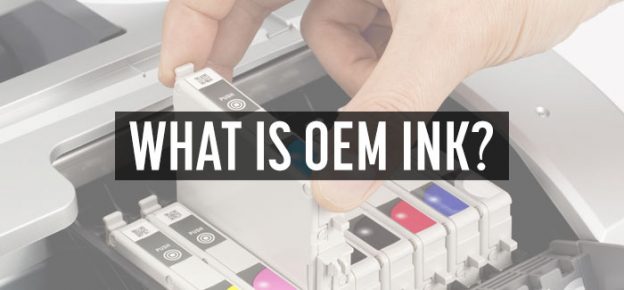Buying replacement ink for your printer? You should know the difference between “OEM” and “non-OEM” ink. Essentially OEM comes directly from the original manufacturer, and “non-OEM” is the generic equivalent. Here’s a full explanation:
So, What is OEM ink?
OEM stands for “original equipment manufacturer.” It’s just a fancy and confusing way of saying that it is “genuine brand name ink.”
OEM ink comes directly from manufacturers like Canon, HP, and Epson. OEM ink is always more expensive than it’s “non-OEM” equivalent.
Then, what is a “non-OEM” ink cartridge?
A non-OEM ink product is a generic, or “compatible” version.
Compatible ink is essentially ink or toner manufactured by a third party that is designed to work with specific printers. The concept is very similar to that of generic drugs, as name brand compatible ink is much cheaper than what is known as name brand “OEM” ink.
Compatible ink has been a thorn in the side of big brand names like Canon and Lexmark, as it has grown to a multi-billion dollar business; commanding about 25% of the replacement ink and toner market. This has spurred a number of lawsuits from large brands claiming copyright infringement and unfair competition against companies like 123inkjets and 4inkjets.
The result of a 2007 lawsuit against 123inkjets brought by Epson reaffirmed that these “compatible” inkjet cartridges must be labeled as such (or as refilled, or remanufactured) so as not imply that they are being sold or endorsed by the original company. It also restated that a number of regulations be enforced against compatible ink including manufacturing, quality, and import laws.
*New: 500 Business Cards for $10 from Vistaprint!
How is compatible ink different than recycled ink?
The two products are actually similar in a lot of respects, but the main difference is that compatible inkjets are made with all new parts and materials, whereas recycled, refilled or remanufactured” ink is sold in the reused containers of name brand ink.
- 10% off + free shipping at 4inkjets.com!
Reusing these mostly plastic containers allows purveyors of recycled ink to make the claim that their product is friendly for the environment.
Is Generic (Compatible) ink as good of a quality as name brand ink?
Most third party tests show little difference between compatible and OEM ink, but there is debate among some customers as to whether they are equals.
Although most compatible ink performs to high quality standards, (known as iso 9001 standards) a number of the negative reviews that I have found claim that the color prints and copies from compatible ink are not as bright and durable as OEM inkjets and toners.
OEM Ink: Our conclusion
I think that it is a personal choice whether to buy name brand or compatible ink the same way there is often a choice between name brand and generic at the drugstore. If you are printing photographs or high quality glossy images, I think you should lean towards paying extra for the real McCoy, aka, “OEM,” even though they are excluded from coupons.
If you are like me and mostly print out things that won’t be scrutinized for quality, you should lean towards the cheaper compatible inkjet alternative.
Also, if you run a small business or print a large volume of pages each month, the cost difference becomes more of a factor, as that 20-50% that you save with generic ink could mean hundreds of dollars.

